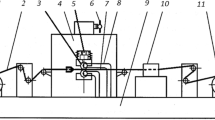Abstract
On the basis of the well-known mechanism of electroplastic deformation, we suggest a method for determination of the fraction of energy of pulses of the electric current directly spent on the work of plastic deformation. The experimental data presented in the work confirm the validity of the proposed approach.
Similar content being viewed by others
References
V. S. Bobrov and Yu. A. Osip’yan, “Thermal softening of metals,”Fiz. Tverd. Tela, 15, No. 11, 3266–3268 (1973).
K. M. Klimov and I. I. Novikov, “Influence of the temperature gradient and high-density electrical currents on the tensile plastic deformation of metallic wires,”Izv. Akad. Nauk SSSR, Ser. Met., No. 6, 175–179 (1978).
K. M. Klimov and I. I. Novikov, “On the problem of the ‘electroplastic effect’,”Probl. Prochn., No. 1, 98–103 (1984).
N. N. Beklemishev and G. S. Shapiro, “Plasticity and strength of conducting metals under the action of high-energy currents,” in:Strength, Plasticity, and Viscoelasticity of Materials and Structures [in Russian], Sverdlovsk (1986), pp. 20–28.
Yu. N. Golovin, “Mechanical properties and behavior of actual metals in strong electric and magnetic fields,”Izv. Vyssh. Uchebn. Zaved., Chern. Metallurgiya, No. 8, 67–71 (1993).
V. Ya. Kravchenko, “Interaction of a directed flow of electrons with moving dislocations,”Zh. Eksp. Teor. Fiz.,51, Issue 6, 1676–1688 (1966).
L. B. Zuev, V. E. Gromov, V. F. Kurilov, and L. I. Gurevich, “Mobility of dislocations in monocrystals of zinc under the action of current pulses,”Dokl. Akad. Nauk SSSR,239, No. 1, 84–86 (1978).
V. I. Spitsyn and O. A. Troitskii,Electroplastic Deformation of Metals [in Russian], Nauka, Moscow (1985).
A. F. Sprecher, S. L. Mannan, and H. Conrad, “On the mechanisms for the electroplastic effect in metals,”Acta Met.,34, No. 7, 1145–1162 (1986).
A. A. Kopanev, “On the problem of the nature of the electroplastic effect in metals,”Probl. Prochn., No. 1, 47–51 (1991).
O. A. Troitskii, V. I. Spitsyn, and V. I. Stashenko, “Influence of the main parameters of the current on the strength of the electroplastic effect,”Dokl. Akad. Nauk SSSR,256, No. 5, 1134–1137 (1981).
G. S. Pisarenko, V. A. Strizhalo, and L. S. Novogrudskii, “On the resistance of metallic materials to the plasticizing action of current pulses,”Probl. Prochn., No. 7, 21–24 (1989).
B. G. Lifshits, V. S. Kraposhin, and Ya. L. Linetskii,Physical Properties of Metals and Alloys [in Russian], Metallurgiya, Moscow (1980).
N. E. Alekseevskii, Yu. N. Gaidukov, Z. S. Gribinkov, et al.,Conduction Electrons [in Russian], Nauka, Moscow (1985).
Additional information
The present work was partially financially supported by the International Science Foundation and the Ukrainian Government (Grant UBW 200).
Institute for Problems of Strength, National Academy of Sciences of Ukraine, Kiev, Ukraine. Translated from Problemy Prochnosti, No. 4, pp. 38–43, July–August, 1997.
Rights and permissions
About this article
Cite this article
Strizhalo, V.A., Novogrudskii, L.S. Determination of the energy of electroplastic deformation of metals. Strength Mater 29, 345–349 (1997). https://doi.org/10.1007/BF02767818
Received:
Issue Date:
DOI: https://doi.org/10.1007/BF02767818



